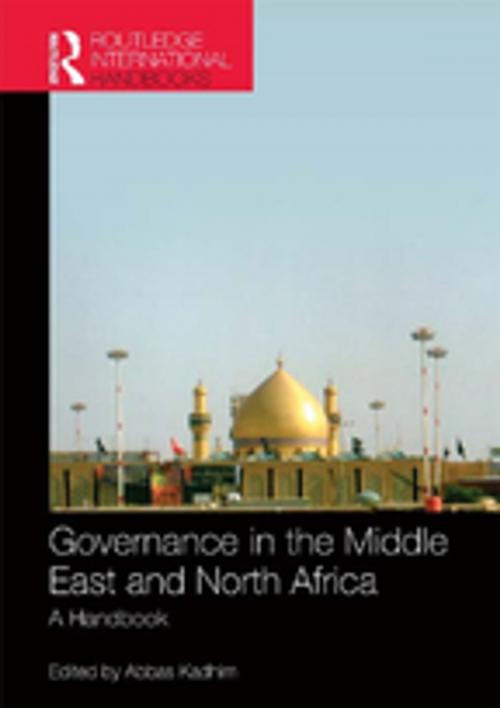Governance in the Middle East and North Africa
A Handbook
Nonfiction, Social & Cultural Studies, Political Science, Politics, Reference, International, Foreign Legal Systems| Author: | ISBN: | 9781136959660 | |
| Publisher: | Taylor and Francis | Publication: | February 15, 2013 |
| Imprint: | Routledge | Language: | English |
| Author: | |
| ISBN: | 9781136959660 |
| Publisher: | Taylor and Francis |
| Publication: | February 15, 2013 |
| Imprint: | Routledge |
| Language: | English |
Governance in the Middle East is topic of interest to scholars, activists and policy makers. The currently proposed book is intended to present the first comprehensive framework of the question of governance in the Middle East in its various forms and manifestations: political, economic, and government performance. This study will supply the context that is missing in the existing literature on, perhaps, the last bastion of authoritarianism in the world.
Proposed Contents
This book will be structured into two parts: Part I (Chapters 1-11) provides some theoretical background and analyzes the patterns and challenges of governance in the Middle East, providing some global context; Part II (12-Conclusion) will examine specific cases in selected countries and regions in the Middle East.
Part I: Theory and Context
Chapter 1 will be an introduction describing the main aspects of the book and highlighting the main points made by the contributors.
Chapter 2 will present the theoretical dimensions of governance and review the "state of the discipline" and the latest trends in the literature on governance. The author of this chapter will be an authority in the subject of governance, but does not have to be necessarily a Middle East scholar.
Chapter 3 will examine the general political trends in the Middle East and provide a historical background: nation-state formation, colonial and postcolonial experiences in the Middle East and the nature of the Middle Eastern political environment at the present time.
Chapter 4 will look into the economic aspects of governance in the Middle East and contextualize the economic challenges and deficiencies affecting the region.
Chapter 5 will examine the areas of success and failure in government performance in the region and the aspects of human development.
Chapter 6 will look into the role of religion in shaping the governance in the Middle East. After all, most Middle Eastern governments declare Islam as the State religion, while a few consider Islam the source of governance and legislation (e.g. Saudi Arabia and Iran).
Chapter 7 will shed light on the sectarian division among Muslims (Shi‘a vs. Sunnis) and the significance of this division for the governance, particularly in countries where the ruling groups belong to a different sect than the governed, such as Bahrain, Saudi, Kuwait and Lebanon.
Chapter 8 will examine relation between the state of governance in the Middle East and the progress of human rights, or lack thereof. The Middle East remains one of the most troubling regions on human rights and the respect for human dignity. All of the region’s governments are heavily implicated in very serious violations of the most basic in human rights.
Chapter 9 will focus on the status of women in the Middle East and the governmental performance in the region in relevance to women rights and status. The recent years have witnessed many positive changes in this regard, but there remains a lot of work to be done, which is going to be outlined in this chapter.
Chapter 10 will look into the role of oil and other natural sources in shaping the economic and political performance of Middle Eastern governments. Also, it will shed light on the various ways these governments distribute the revenues (rents) from these resources and how they use them, or don’t, in the development of their countries or, in most cases, on the military and state oppressive machine.
Chapter 11 will examine the role of international organizations and trade agreements on the performance of governments and whether or not such factors influence or shape governance in the region. It is well-known that Turkey has changed many of its laws and social policies in response to the demands of EU members and in hopes of being admitted into the EU. The chapter will elaborate on this and similar cases throughout the region.
Part II: Case Studies
Chapter 12 will examine the case of Iraq. The country is experiencing perhaps the most dramatic scenarios of governance in the region. This chapter will shed light on the unfolding political process and the struggle of Iraqis to forge a path toward democracy in a region determined to resist any political change within its boundaries. Key issues: Power-sharing, pluralism, federalism, ethnic and sectarian conflict, trust-building, corruption and political violence.
Chapter 13 will examine the case of Iran. Thirty years after the Islamic Revolution, Iran is entering into a soul-searching phase in its history. The ongoing battle between the reformers and the hardliners is only a sign on the larger problem of governance. A majority of Iranians have no personal recollection of the problems that led to the Revolution. It is vitally important that the government changes its claims to legitimacy from being the force that toppled the Shah to being the provider of prosperity and development of the country and its young population. Key issues: Political reform, human rights, reconciliation with the West, allocation of resources and services.
Chapter 14 will examine the case of Egypt. The country is facing an unknown future with President Mubarak reaching advanced age. The debate over his succession is dividing the country in a dramatic way. Egypt is also a country with depleted infrastructure and an ever-shrinking middle class. If the country falls into a violent cycle after the looming departure of Mubarak, the entire region could fall into the abyss. Key issues: Succession of Mubarak, economic performance, services, religious extremism (Muslim Brotherhood) and Nationalism.
Chapter 15 will examine the case of Israel. While politically different from its neighbors, Israel is sinking fast into the same problems that plague the Middle East. The country suffers political corruption and many leadership crises. The government is trying to redefine the identity of the state, which is going to create a showdown with the fast-growing non-Jewish Israeli population, and there is the problem of the government’s inability to conclude peace with Israel’s neighbors. Key issues: corruption, violence and security.
Chapter 16 will examine the case of Saudi Arabia. The country is perhaps the most authoritarian regime in the world. The lack of individual liberties and abuses of human rights are the main problems. The government’s treatment of its Shia subjects (approx. 12% of the population) as second-class residents is extremely troubling. The country does not have a meaningful public participation and the Royals who run the government have no accountability to anyone. Key issues: human rights, religious freedom, political reform, public participation.
Chapter 17 will examine the case of Bahrain. This small country in the Persian Gulf is facing many challenges. Like Iraq before 2003, it is a country with a clear Shia majority ruled by a small Sunni minority. The Shia are excluded from the government (they were allowed to run for the parliament in the last election for the first time), the military and many other important arenas. The government uses the naturalization of Sunnis as a political tool to change the demographic balance in the country. Key issues: political reform, popular participation, naturalization, human rights.
Chapter 18 will examine the case of Yemen. The current struggle over government performance and fairness toward the South has given rise to the calls for separation of the two parts of Yemen. Also, there is the issue of religious freedom, which cases the ongoing war with the Houthi faction that accuses the government of making alliance with the Saudi government and the Sunni extremists in the country to form an existential threat to Shi’ism. Yemen is also a country with many ungoverned spaces and the governance in the "governed" areas is abysmal. Key issues: political violence, human and religious rights, terrorism, tribalism and poverty.
Chapter 19 will examine the case of Turkey and its impressive rise as a model for a strong Muslim nation which tries to reconcile Islam and democracy. Turkey’s longstanding problems with social rights, especially of its 12 million Kurds, have always been a formidable challenge to the image of the nation. However, the country’s bid to join the EU has forced many changes that inadvertently helped the government’s international standing.
Chapter 20 will examine the case of Syria and the influence of the Arab nationalist ideology on keeping the country as one of the most oppressive regimes in the region. Also examined will be the affect of Syrian-Israeli conflict on the country’s governance.
Chapter 21 examines the case of Lebanon. This country which witnessed more governance challenges than any other in the region makes a very interesting case study. The country’s sectarian politics and the client-patron relations and loyalties among the various Muslim and Christian elements of society have undermined the country’s potential to become a fully democratic state.
Chapter 22 will focus on the case of Sudan. This country has been in the center of world attention because of the internal conflict and the accusations of serious violations of human rights and the rise of separatist movements that receive much foreign sympathy and support. The country has missed many opportunities to attain social and political reconciliation, but it should not be considered a lost cause. There is a lot of potential in the country, especially when we consider the vibrant politics of government and opposition.
Chapter 23 will examine the case of Jordan and the role of the uniqueness of the regime in creating relative social and political stability. Unlike the most of the governments in the region, the Jordanian Monarchy keeps the government as a convenient buffer between the Royals and the people. When popular sentiments turn very negative, the King, acting as the good cop, dismisses the government and orders the formation of a new one. Also, Jordan has achieved some good success in absorbing the Islamist groups into the political system, but not without challenges. The chapter will also focus on the Palestinian factor – Palestinians make more than half of the Jordanian population.
Chapters 24, 25 & 26 will examine the Maghreb states (Morocco, Algeria and Tunisia). These states face many challenges in their governance: separatism, terrorism and the government oppressive history in Morocco; the Islamism challenge, internal war in the tribal areas and ethnic conflict in Algeria; and the stifling of personal freedom and liberties in Tunisia in the name of secularism and the war on extremism are all challenges that need to be highlighted in a chapter about each country.
Chapter 27 will focus on governance in Libya. Having ruled the country for forty-seven years, the Libyan president is the dean of Middle Eastern dictators. He has taken his country though all kinds of political adventures. The rule through popular committees is a unique system that gives Col. Mu‘ammar Qadhafi the opportunity to oppress through popular participation and acquiescence.
Chapter 28 will focus on the governance in the United Arab Emirates. This confederation of seven emirates has witnessed some excellent success in the economic and infrastructural development, especially in Dubai, which competes with the richest cities in the world, thanks to the energy and vision of its Emir, Muhammad b. Rashid. While it is generally considered much better than its fellow Gulf States, the UAE has its own challenges, especially in light of the absence of unified system of governance, because each emirate has the autonomy to shape its internal affairs.
Chapter 29 will examine the governance and, in certain cases, lack thereof in the countries that form the Horn of Africa, i.e. Somalia, Eritrea and Djibouti. These countries face some tremendous challenges in the areas of refugees, resources, stability and ethnic & conflict. The failure of these states, as seen in the case of Somalia, can make the problems of security in the whole region much worse than it is now. Famine and anarchy have already led to wars, piracy and the flood of refugees, not to say much about the humanitarian catastrophes in the region. This chapter will highlight the problems of governance in these often forgotten countries.
Chapter 30 will be a conclusion and final remarks on the general framework of the regional governance and the way forward.
This book is aimed at a wide variety of audience. Policy makers, policy analysts, as well as journalists will benefit from the history and analysis that will be presented in the book. Also, academics will find in the book important materials for research and class work. Professors teaching courses on US Foreign policy, Middle East, International Relations, Comparative Politics and many related fields will find the book a very suitable choice for their students to read. Given the media and general public’s interest in the Middle East and the Middle East, the book will also appeal to a wide range of educated readers in the United States, the United Kingdom and many other countries world-wide.
Governance in the Middle East is topic of interest to scholars, activists and policy makers. The currently proposed book is intended to present the first comprehensive framework of the question of governance in the Middle East in its various forms and manifestations: political, economic, and government performance. This study will supply the context that is missing in the existing literature on, perhaps, the last bastion of authoritarianism in the world.
Proposed Contents
This book will be structured into two parts: Part I (Chapters 1-11) provides some theoretical background and analyzes the patterns and challenges of governance in the Middle East, providing some global context; Part II (12-Conclusion) will examine specific cases in selected countries and regions in the Middle East.
Part I: Theory and Context
Chapter 1 will be an introduction describing the main aspects of the book and highlighting the main points made by the contributors.
Chapter 2 will present the theoretical dimensions of governance and review the "state of the discipline" and the latest trends in the literature on governance. The author of this chapter will be an authority in the subject of governance, but does not have to be necessarily a Middle East scholar.
Chapter 3 will examine the general political trends in the Middle East and provide a historical background: nation-state formation, colonial and postcolonial experiences in the Middle East and the nature of the Middle Eastern political environment at the present time.
Chapter 4 will look into the economic aspects of governance in the Middle East and contextualize the economic challenges and deficiencies affecting the region.
Chapter 5 will examine the areas of success and failure in government performance in the region and the aspects of human development.
Chapter 6 will look into the role of religion in shaping the governance in the Middle East. After all, most Middle Eastern governments declare Islam as the State religion, while a few consider Islam the source of governance and legislation (e.g. Saudi Arabia and Iran).
Chapter 7 will shed light on the sectarian division among Muslims (Shi‘a vs. Sunnis) and the significance of this division for the governance, particularly in countries where the ruling groups belong to a different sect than the governed, such as Bahrain, Saudi, Kuwait and Lebanon.
Chapter 8 will examine relation between the state of governance in the Middle East and the progress of human rights, or lack thereof. The Middle East remains one of the most troubling regions on human rights and the respect for human dignity. All of the region’s governments are heavily implicated in very serious violations of the most basic in human rights.
Chapter 9 will focus on the status of women in the Middle East and the governmental performance in the region in relevance to women rights and status. The recent years have witnessed many positive changes in this regard, but there remains a lot of work to be done, which is going to be outlined in this chapter.
Chapter 10 will look into the role of oil and other natural sources in shaping the economic and political performance of Middle Eastern governments. Also, it will shed light on the various ways these governments distribute the revenues (rents) from these resources and how they use them, or don’t, in the development of their countries or, in most cases, on the military and state oppressive machine.
Chapter 11 will examine the role of international organizations and trade agreements on the performance of governments and whether or not such factors influence or shape governance in the region. It is well-known that Turkey has changed many of its laws and social policies in response to the demands of EU members and in hopes of being admitted into the EU. The chapter will elaborate on this and similar cases throughout the region.
Part II: Case Studies
Chapter 12 will examine the case of Iraq. The country is experiencing perhaps the most dramatic scenarios of governance in the region. This chapter will shed light on the unfolding political process and the struggle of Iraqis to forge a path toward democracy in a region determined to resist any political change within its boundaries. Key issues: Power-sharing, pluralism, federalism, ethnic and sectarian conflict, trust-building, corruption and political violence.
Chapter 13 will examine the case of Iran. Thirty years after the Islamic Revolution, Iran is entering into a soul-searching phase in its history. The ongoing battle between the reformers and the hardliners is only a sign on the larger problem of governance. A majority of Iranians have no personal recollection of the problems that led to the Revolution. It is vitally important that the government changes its claims to legitimacy from being the force that toppled the Shah to being the provider of prosperity and development of the country and its young population. Key issues: Political reform, human rights, reconciliation with the West, allocation of resources and services.
Chapter 14 will examine the case of Egypt. The country is facing an unknown future with President Mubarak reaching advanced age. The debate over his succession is dividing the country in a dramatic way. Egypt is also a country with depleted infrastructure and an ever-shrinking middle class. If the country falls into a violent cycle after the looming departure of Mubarak, the entire region could fall into the abyss. Key issues: Succession of Mubarak, economic performance, services, religious extremism (Muslim Brotherhood) and Nationalism.
Chapter 15 will examine the case of Israel. While politically different from its neighbors, Israel is sinking fast into the same problems that plague the Middle East. The country suffers political corruption and many leadership crises. The government is trying to redefine the identity of the state, which is going to create a showdown with the fast-growing non-Jewish Israeli population, and there is the problem of the government’s inability to conclude peace with Israel’s neighbors. Key issues: corruption, violence and security.
Chapter 16 will examine the case of Saudi Arabia. The country is perhaps the most authoritarian regime in the world. The lack of individual liberties and abuses of human rights are the main problems. The government’s treatment of its Shia subjects (approx. 12% of the population) as second-class residents is extremely troubling. The country does not have a meaningful public participation and the Royals who run the government have no accountability to anyone. Key issues: human rights, religious freedom, political reform, public participation.
Chapter 17 will examine the case of Bahrain. This small country in the Persian Gulf is facing many challenges. Like Iraq before 2003, it is a country with a clear Shia majority ruled by a small Sunni minority. The Shia are excluded from the government (they were allowed to run for the parliament in the last election for the first time), the military and many other important arenas. The government uses the naturalization of Sunnis as a political tool to change the demographic balance in the country. Key issues: political reform, popular participation, naturalization, human rights.
Chapter 18 will examine the case of Yemen. The current struggle over government performance and fairness toward the South has given rise to the calls for separation of the two parts of Yemen. Also, there is the issue of religious freedom, which cases the ongoing war with the Houthi faction that accuses the government of making alliance with the Saudi government and the Sunni extremists in the country to form an existential threat to Shi’ism. Yemen is also a country with many ungoverned spaces and the governance in the "governed" areas is abysmal. Key issues: political violence, human and religious rights, terrorism, tribalism and poverty.
Chapter 19 will examine the case of Turkey and its impressive rise as a model for a strong Muslim nation which tries to reconcile Islam and democracy. Turkey’s longstanding problems with social rights, especially of its 12 million Kurds, have always been a formidable challenge to the image of the nation. However, the country’s bid to join the EU has forced many changes that inadvertently helped the government’s international standing.
Chapter 20 will examine the case of Syria and the influence of the Arab nationalist ideology on keeping the country as one of the most oppressive regimes in the region. Also examined will be the affect of Syrian-Israeli conflict on the country’s governance.
Chapter 21 examines the case of Lebanon. This country which witnessed more governance challenges than any other in the region makes a very interesting case study. The country’s sectarian politics and the client-patron relations and loyalties among the various Muslim and Christian elements of society have undermined the country’s potential to become a fully democratic state.
Chapter 22 will focus on the case of Sudan. This country has been in the center of world attention because of the internal conflict and the accusations of serious violations of human rights and the rise of separatist movements that receive much foreign sympathy and support. The country has missed many opportunities to attain social and political reconciliation, but it should not be considered a lost cause. There is a lot of potential in the country, especially when we consider the vibrant politics of government and opposition.
Chapter 23 will examine the case of Jordan and the role of the uniqueness of the regime in creating relative social and political stability. Unlike the most of the governments in the region, the Jordanian Monarchy keeps the government as a convenient buffer between the Royals and the people. When popular sentiments turn very negative, the King, acting as the good cop, dismisses the government and orders the formation of a new one. Also, Jordan has achieved some good success in absorbing the Islamist groups into the political system, but not without challenges. The chapter will also focus on the Palestinian factor – Palestinians make more than half of the Jordanian population.
Chapters 24, 25 & 26 will examine the Maghreb states (Morocco, Algeria and Tunisia). These states face many challenges in their governance: separatism, terrorism and the government oppressive history in Morocco; the Islamism challenge, internal war in the tribal areas and ethnic conflict in Algeria; and the stifling of personal freedom and liberties in Tunisia in the name of secularism and the war on extremism are all challenges that need to be highlighted in a chapter about each country.
Chapter 27 will focus on governance in Libya. Having ruled the country for forty-seven years, the Libyan president is the dean of Middle Eastern dictators. He has taken his country though all kinds of political adventures. The rule through popular committees is a unique system that gives Col. Mu‘ammar Qadhafi the opportunity to oppress through popular participation and acquiescence.
Chapter 28 will focus on the governance in the United Arab Emirates. This confederation of seven emirates has witnessed some excellent success in the economic and infrastructural development, especially in Dubai, which competes with the richest cities in the world, thanks to the energy and vision of its Emir, Muhammad b. Rashid. While it is generally considered much better than its fellow Gulf States, the UAE has its own challenges, especially in light of the absence of unified system of governance, because each emirate has the autonomy to shape its internal affairs.
Chapter 29 will examine the governance and, in certain cases, lack thereof in the countries that form the Horn of Africa, i.e. Somalia, Eritrea and Djibouti. These countries face some tremendous challenges in the areas of refugees, resources, stability and ethnic & conflict. The failure of these states, as seen in the case of Somalia, can make the problems of security in the whole region much worse than it is now. Famine and anarchy have already led to wars, piracy and the flood of refugees, not to say much about the humanitarian catastrophes in the region. This chapter will highlight the problems of governance in these often forgotten countries.
Chapter 30 will be a conclusion and final remarks on the general framework of the regional governance and the way forward.
This book is aimed at a wide variety of audience. Policy makers, policy analysts, as well as journalists will benefit from the history and analysis that will be presented in the book. Also, academics will find in the book important materials for research and class work. Professors teaching courses on US Foreign policy, Middle East, International Relations, Comparative Politics and many related fields will find the book a very suitable choice for their students to read. Given the media and general public’s interest in the Middle East and the Middle East, the book will also appeal to a wide range of educated readers in the United States, the United Kingdom and many other countries world-wide.















